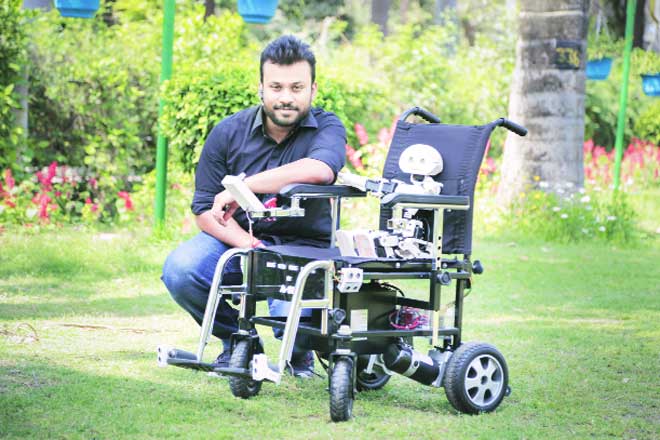
Once an active government employee, Prem Das is now not able to leave his bed even for a moment. He suffered complete paralysis in August 2014. Since then, he is undergoing physiotherapy, but still is unable to move on his own.
There are thousands of people like Das in India. While their cure depends on multiple treatments—and sometimes such cases are incurable—a brain-controlled wheelchair can at least make their lives easier.
One such wheelchair has recently been invented by 23-year-old Diwakar Vaish, who is the head of Robotics and Research at A-SET Training and Research Institutes, New Delhi. His invention is aptly called ‘Samarth’, which in Sanskrit translates into ‘competence’, ‘capability’, ‘power’.
Last year, Vaish created ‘Manav’—a 3D printed humanoid robot that, he claims, responds to human voice commands and can even perform various dance moves such as Bhangra.
Vaish claims that Samarth is the world’s first brain-controlled production wheelchair. “Renowned physicist Stephen Hawking’s wheelchair is controlled by either a joystick or by his cheek movement. There is no involvement of the brain in any way,” he says.
While Vaish and his team have been working on brain sensors for close to five years, the concept of a brain-controlled wheelchair struck him last year. He claims to have turned this project into reality in just one year.
Vaish says Samarth can be used by patients suffering from locked-in syndrome (LIS) or complete paralysis. LIS is a condition in which a patient loses control over most muscles and is not able to move any body part—a patient is able to see and hear, but can’t react.
How does it work?
Our brain is made up of millions of neurons, and when we think, the neurons emit electric impulses. These signals pass from our brain to the scalp in minute amounts. An EEG sensor—electroencephalography—which the patient has to wear on his head, senses these signals. These are then amplified, filtered and sent to a system that converts them into meaningful data. The wheelchair has been designed in such a way that it moves, say, not only on the blinking of eyes, but even if you think about blinking your eyes. However, if you, say, clench your eyes in fear, the wheelchair will not move.
“The wheelchair is equipped with a system which automatically warns the people nearby in case it gets stuck. The sensors allow the speed to be consistent even in the case of inclined surfaces. If a wrong command is given—say, you think something that is detrimental to yourself—the wheelchair won’t move until it checks if the move is safe for the user,” claims Vaish. The sensors constantly map the areas around the chair, and if there is, say, a pit or a drop ahead, the sensors will stop its movement. It can get recharged fully in four hours, and on a full charge it can operate for 2-4 days. It costs R2 lakh, including taxes.
Globally, scientists have been working on similar products. Recently, researchers at Duke University successfully navigated monkeys in a room using a brain-controlled wheelchair. But so far it has not been tried on humans. So, technically, India can boast of a brain-controlled wheelchair developed indigenously for commercial purposes. But, as of now, Samarth has not been certified by any Indian organisation; Vaish has said he will be applying for Indian as well as American patent in due course of time.
Source: financialexpress.com









































